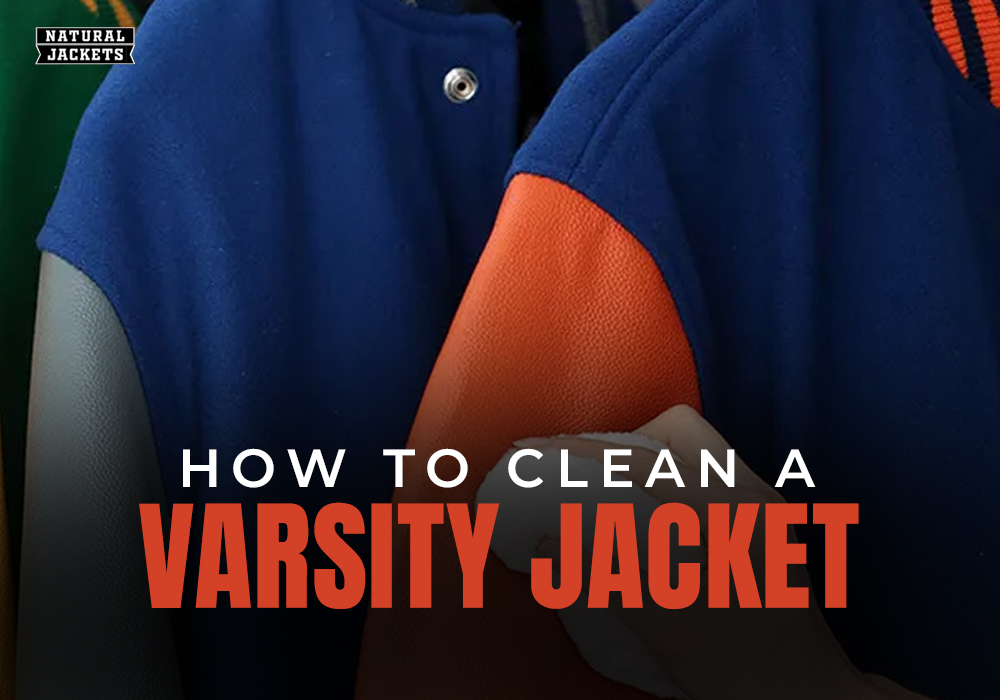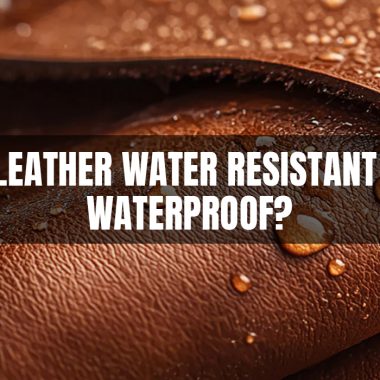Table of Contents
Varsity jackets aren’t like regular jackets. They’re heavier, often made from a mix of wool and leather, and have those bold patches that make them stand out. You can feel the difference the moment you pick one up. And that’s exactly why they don’t fit into a one-size-fits-all cleaning routine. Tossing them into a washing machine like you would with a hoodie? That’s a quick way to mess them up. The materials can shrink, crack, or fade if you’re not careful.
So if you’re wondering how to clean a varsity jacket without ruining it, you’re in the right place. This guide breaks it down in a way that’s simple, clear, and safe for your jacket, whether it’s new or something you’ve had for years.
Can You Wash Letterman Jackets?
It’s one of the most common questions people ask—and the answer isn’t as simple as yes or no. Technically, yes, you can wash a letterman jacket, but the real question is: should you? And in most cases, the answer is no, not if you want to keep it in good shape.
Varsity jackets are made from a mix of materials that don’t all respond well to water, agitation, or heat. Wool can shrink. Leather sleeves can dry out and crack. Even the ribbed cuffs and chenille patches can get distorted. Most of the damage people see comes from throwing these jackets into washing machines or dryers without thinking twice.
That said, there are some ways to safely refresh your jacket at home, especially if you’re dealing with light surface dirt or odor. But for anything beyond that, a more cautious approach is needed.
Understanding Your Jacket: Fabric and Sleeve Matters
Varsity jackets look simple at first glance, but they’re not built like regular coats. Most are made using a mix of different materials—usually wool for the body and some type of leather or leather alternative for the sleeves. Add chenille patches, ribbed trim, and an inner lining, and suddenly you’ve got a jacket that reacts very differently depending on how you clean it.
That’s why it’s important to know what your jacket’s made of before you do anything. Cleaning the wrong part the wrong way can ruin the fit, texture, or finish.
Here’s a quick breakdown of what you might be working with:
Wool (Body): It’s thick and warm, but shrinks fast if exposed to heat or soaked in water. It also tends to lose its shape when handled roughly.
PU or Vegan Leather (Sleeves): These aren’t as tough as they look. Too much moisture, scrubbing, or the wrong product can make the sleeves peel or crack.
If you’re not sure what kind of leather you have, check this out: Different Types of Leather Jackets.
Chenille Patches: These are the big letters or logos stitched on. They feel fuzzy and raised, but they’re easy to flatten or damage with the wrong cleaning method.
Ribbed Cuffs and Hem: These stretchy areas keep the fit snug, but they stretch out or fray if they’re scrubbed too hard or dried with heat.
Lining (Inside): Usually soft and smooth, it collects sweat and odor over time, even if the outside looks clean.
How to Clean a Varsity Jacket with Leather Sleeves
Cleaning a varsity jacket with leather sleeves is a bit of a balancing act. You’ve got to be gentle with the leather while still getting the surface clean, and without letting moisture soak into the wool body. That’s where most people go wrong.
One wrong move and you’ll end up with dried-out sleeves or water marks that are hard to fix. The good news is that if you take your time and use the right tools, it’s easier than you’d think.
Step-by-Step:
Step 1: Read the Tag Inside First
Start by checking the little care tag inside your jacket—it’ll tell you what kind of leather you’re working with. Real leather? PU? Vegan? That small detail makes a big difference in how you clean it.
Step 2: Wipe Off the Surface Gently
Use a dry microfiber cloth or something soft to remove dust or anything sitting on the sleeves. No pressure here—just a quick sweep to clear the surface.
Step 3: Dampen a Cloth for Spot Cleaning
Take a bowl of lukewarm water and mix in a few drops of gentle soap. Something like baby shampoo works fine. Dip a clean cloth, wring it almost dry, and wipe the leather gently. Don’t go overboard—too much water can leave marks.
Step 4: Pat It Dry and Let It Air Out
Right after you wipe, grab another cloth and dab the sleeves dry. Don’t leave moisture sitting there. Let the jacket dry naturally, flat on a surface, away from sunlight, heaters, or anything that blows hot air.
Step 5: Use Leather Conditioner if It’s Real Leather
If your sleeves are genuine leather, a small amount of conditioner can really help. It keeps them soft and keeps cracks away. Skip this step if you’re dealing with PU or synthetic materials.
How to Clean a Wool Varsity Jacket Without Damaging It
Wool might be warm and durable, but it’s also tricky. Clean it the wrong way, and you could end up with a jacket that’s smaller, stiffer, or just doesn’t look the same. Most damage happens because people use too much water, rough brushes, or heat. The truth is, when it comes to varsity jacket cleaning, wool requires a softer approach. Below are some quick steps to help you clean the wool body of your jacket without wrecking its shape or texture.
How to Clean the Wool Body Safely:
Use a Garment Brush First
- Before you bring in water, brush the jacket gently with a garment or lint brush. This lifts off surface dirt, hair, and dust without damaging the fabric.
Spot Clean with a Mild Detergent
- Mix cold water with a little wool-safe detergent. Dip a clean cloth in, wring it nearly dry, and blot the dirty spots. Avoid scrubbing or rubbing, especially on seams.
Skip the Soaking
- Never soak the wool body in water—not even a little. Wool absorbs moisture fast and loses shape quickly when wet.
Pat the Spot with a Towel
- After spot cleaning, take a dry towel and press it on the area you just cleaned. Not wipe—just press and hold. Once the moisture is out, lay the jacket flat to dry in a cool, shaded area.
Quick Deodorizing Trick (If Needed)
- If the jacket smells off but isn’t actually dirty, you can mist a little fabric spray from a distance—don’t drench it. Then hang the jacket in the open air for a while. Even a shaded balcony works.
Deep Cleaning – Inside Lining, Odor Fixes & Stain Removal
The inside lining of your varsity jacket doesn’t show, but it collects the most sweat and odor over time. If the inside smells off or feels greasy, it’s time to clean it carefully.
Start with a Dry Brush or Vacuum Nozzle
Use a soft clothes brush or handheld vacuum with a gentle setting to remove dust and loose lint.
Spot Clean the Lining
Dampen a cloth with cold water and a drop of mild detergent. Wipe gently on stained or smelly areas—especially under the arms and collar. Don’t drench it.
Handle Stains Immediately
Dab with diluted white vinegar or a small amount of laundry-safe stain remover. Always patch test first.
Let It Air Out Naturally
Hang the jacket inside-out in a shaded, breezy place. Avoid using heat to dry—it can stiffen the lining.
For more fabric-specific tips, check our jacket cleaning methods guide.
When to Go for Professional Cleaning
If your varsity jacket has set-in stains, a strong smell, or patches that feel too tricky to clean by hand, it’s better not to take chances. A professional dry cleaner who knows how to handle wool or leather can do the job safely.
And if your jacket holds personal or sentimental value, you really don’t want to mess that up. DIY cleaning is fine most of the time, but when it feels like the jacket needs more than just a wipe or spot fix, letting a pro take care of it is the smarter call.
Storage & Maintenance Tips to Avoid Frequent Cleaning
Cleaning isn’t everything. The way you hang or store your varsity jacket can mess it up or keep it looking solid for years. Little things matter more than you’d think.
- Use a wide, soft hanger so the shoulders stay in shape.
- Don’t fold or stuff it somewhere — it’ll wrinkle and stretch.
- After wearing, just let it breathe for a bit in the open air.
- During the off-season, toss it in a cloth garment bag, not plastic.
Conclusion
Looking after a varsity jacket doesn’t mean you have to do anything complicated. Just be gentle with it. Give it a quick clean when it looks dusty, hang it up properly, and let it breathe when needed. These jackets aren’t just clothing—they usually mean something.
Maybe a memory, maybe a team. And that’s why they deserve better than being thrown in a pile. A little care here and there goes a long way. Do that, and your jacket will stick around for a good while.
If you’re looking to get a varsity jacket that’s built to last, consider purchasing one from Natural Jackets. Not only will you get a high-quality, timeless piece, but you’ll also be investing in something that holds value beyond just fashion.









